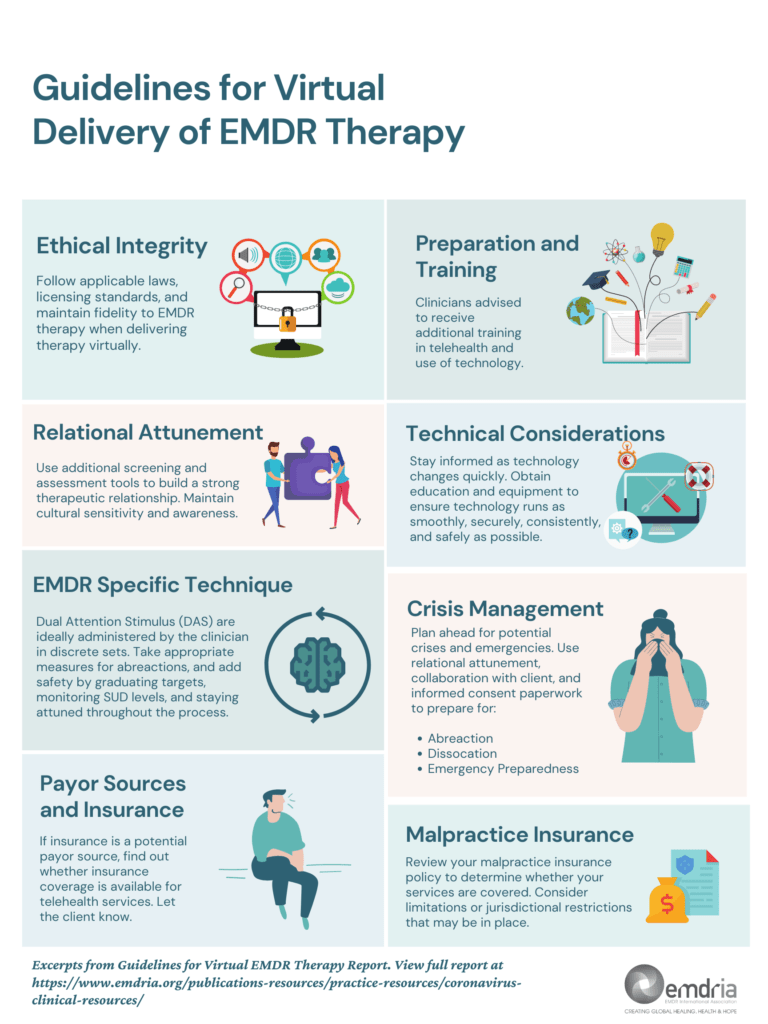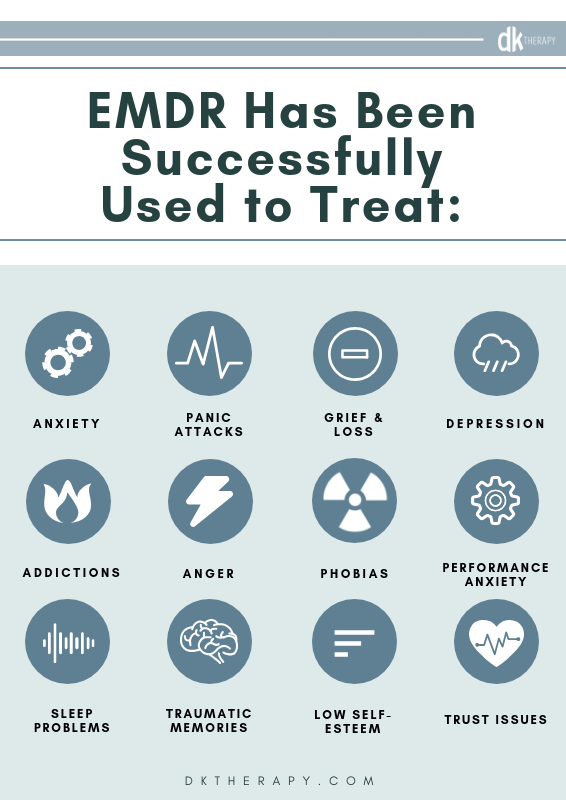The value of bilateral stimulation in emdr therapy for effective results
The Refine of EMDR Treatment: a Comprehensive Guide to Its Benefits and techniques
EMDR treatment attracts attention as an organized method for dealing with traumatic memories. Its multi-phase strategy and consolidation of reciprocal stimulation strategies set it apart from typical therapies. By facilitating the reprocessing of stressful experiences, EMDR provides a distinct pathway to healing. What details techniques are used, and what advantages do they give injury healing? Exploring these elements discloses a deeper understanding of this efficient therapeutic option.
Comprehending EMDR Treatment: A Review
EMDR treatment, or Eye Motion Desensitization and Reprocessing, is a psychotherapy technique designed to ease the distress connected with traumatic memories. Established by Francine Shapiro in the late 1980s, EMDR incorporates elements from various restorative methods, including cognitive-behavioral therapy and psychodynamic therapy. The key objective of EMDR is to aid individuals process and reframe terrible memories, lowering their emotional charge and connected symptoms.
Throughout EMDR sessions, customers take part in twin focus stimuli, usually entailing guided eye movements, while recalling upsetting memories - emdr therapy new york city. This procedure allows the brain to reprocess the memory in a much healthier way. EMDR has actually gained recognition for its efficacy in treating PTSD, clinical depression, and stress and anxiety, amongst various other conditions. Research has actually shown that EMDR can result in significant improvements in psychological health. As a structured intervention, it supplies a thorough structure for therapists to aid customers in getting rid of the effect of past injuries
The Eight Stages of EMDR
While many restorative strategies vary in framework and strategy, the eight phases of EMDR supply an organized structure that overviews the therapeutic process. These stages start with the history-taking and therapy preparation, where the specialist collects pertinent information about the client's experiences and establishes a safe environment. The second phase focuses on preparation, gearing up customers with devices to take care of psychological distress.
In the 3rd stage, clients determine certain memories to target. The 4th phase includes desensitization, where customers refine these memories while engaging in bilateral excitement. The fifth phase emphasizes setup, enhancing positive ideas. The 6th stage addresses body scan techniques to identify any type of recurring tension.
The last 2 phases entail closure, returning clients to a state of balance, and reevaluation, evaluating the efficiency of the therapy. This organized method assurances that EMDR treatment is extensive, dealing with both the mental and physical elements of injury.
Trick Techniques Used in EMDR Sessions
In EMDR sessions, therapists use certain strategies to promote recovery and handling of distressing memories. Trick among these are bilateral stimulation methods, which engage both hemispheres of the brain, and various memory processing techniques that help customers reframe their experiences. Recognizing these techniques is important for grasping the performance of EMDR treatment.
Reciprocal Excitement Approaches
Reciprocal excitement techniques are necessary strategies used during EMDR sessions to assist in the processing of traumatic memories. These approaches entail engaging both hemispheres of the brain, promoting assimilation and recovery. Typical bilateral excitement methods include acoustic hints, such as alternating audios or tones, and responsive stimulation, via making use of portable gadgets that create rotating taps. Aesthetic stimulations, such as the therapist leading the client's eye movements back and forth, are likewise extensively utilized. The balanced nature of these techniques aids to trigger the brain's all-natural processing capacities, enabling customers to reprocess distressing memories in a secure setting. Eventually, reciprocal stimulation fosters a sense of safety and security and boosts the therapeutic experience throughout EMDR.
Memory Processing Methods
Memory handling techniques in EMDR sessions are pivotal for helping customers face and revamp distressing experiences. These techniques concentrate on promoting the reprocessing of stressful memories, enabling clients to integrate and deal with unfavorable emotions related to them. One key method entails using reciprocal stimulation, which can include acoustic tones or responsive sensations, to enhance the brain's data processing capacities. Throughout sessions, customers are guided to remember certain memories while all at once taking part in reciprocal stimulation, advertising a double concentrate on the distressing memory and the here and now moment. This strategy help in lowering the emotional fee of the memory, making it less intrusive. Inevitably, memory handling techniques empower clients to rebuild their narratives, fostering recovery and strength.
The Role of Reciprocal Excitement
Bilateral stimulation is a basic part of EMDR treatment, facilitating the handling of terrible memories. Numerous methods, such as auditory, tactile, and visual excitement, read this article are used to involve both hemispheres of the mind. This method has actually been shown to boost trauma recovery by advertising psychological guideline and decreasing distress related to previous experiences.
System of Bilateral Excitement
The device of reciprocal stimulation plays an important role in promoting the processing of traumatic memories when individuals engage in EMDR therapy. This strategy involves rotating stimulation, typically with auditory, tactile, or visual means, which turns on both hemispheres of the brain. The rhythmic nature of bilateral excitement is believed to imitate the mind's natural handling devices throughout REM sleep, advertising integration of traumatic memories. As clients focus on their stressful experiences while simultaneously engaging in this stimulation, they may experience a decrease in psychological charge linked with those memories. Consequently, this process permits for the reprocessing of injury, resulting in improved psychological regulation and a much more flexible viewpoint on past occasions.
Kinds of Stimulation Methods
Numerous excitement techniques are made use of in EMDR treatment to improve the reprocessing of terrible memories. The key approach is bilateral excitement, that includes auditory, visual, and responsive techniques. Auditory excitement often entails alternating sounds played via headphones, while aesthetic stimulation can consist of directed eye activities back and forth. Tactile excitement may utilize handheld my site devices that develop alternating faucets on the customer's hands. Each of these strategies aims to involve both hemispheres of the brain, helping with an extra efficient handling of stressful memories. Specialists might choose one or a mix of these methods based on customer choices and healing objectives, ensuring a personalized technique to recovery. These techniques are essential for promoting a much deeper assimilation of terrible experiences within the restorative structure.
Benefits for Trauma Recovery
The function of reciprocal excitement in EMDR treatment considerably contributes to injury recuperation by facilitating the processing of upsetting memories. This strategy entails alternating sensory input, usually via eye activities or auditory tones, which aids in integrating distressing experiences. By engaging both hemispheres of the mind, reciprocal excitement boosts emotional guideline and minimizes the strength of stressful memories. Study shows that customers frequently experience a reduction in anxiousness and an enhanced ability to confront upsetting thoughts. Additionally, this method promotes cognitive versatility, enabling individuals to reframe their experiences in a much more adaptive manner. Ultimately, using reciprocal excitement in EMDR treatment plays an essential duty in making it possible for individuals to achieve long-term recovery and durability despite injury.
The Science Behind EMDR: How It Functions
The specific mechanisms of Eye Activity Desensitization and Reprocessing (EMDR) therapy are still being explored, study suggests that it facilitates the handling of terrible memories by incorporating sensory, emotional, and cognitive parts. EMDR utilizes reciprocal stimulation, typically via assisted eye movements, which is thought to mimic the mind's natural handling throughout REM rest. This stimulation may aid clients accessibility and recycle distressing memories, minimizing their emotional fee.
Neuroscientific studies suggest that EMDR might alter the way distressing memories are stored in the brain, promoting adaptive resolution. The therapy urges individuals to face their memories and linked beliefs, allowing them to reframe their experiences. Additionally, the structured phases of EMDR-- such as history-taking, desensitization, and installment-- sustain an extensive expedition of the injury, fostering combination of the fragmented elements of the memory. This procedure inevitably intends to restore a sense of balance and emotional wellness.
Advantages of EMDR for Injury Recuperation
EMDR treatment offers various benefits for individuals recuperating from trauma, especially by resolving the psychological and cognitive distortions associated with terrible experiences. One significant advantage is its ability to assist in rapid processing of stressful memories, often causing a reduction in signs such as stress and anxiety and anxiety. This method enables clients to confront their injury in a organized and safe environment, fostering durability and emotional regulation.
Additionally, EMDR aids people reframe adverse beliefs associated with their injury, advertising a healthier self-image and restoring a feeling of control. The treatment can enhance total emotional wellness and empower customers to regain their lives, making it a valuable device in trauma recuperation. EMDR is suitable for numerous age groups and can be adjusted to meet the details requirements of people, making it a versatile alternative for those looking for to heal from their stressful experiences effectively.
Who Can Profit From EMDR Therapy?
Individuals from varied backgrounds and experiences can gain from EMDR treatment, particularly those that have actually experienced injury in numerous my website forms. This consists of survivors of childhood abuse, all-natural disasters, crashes, and battle experiences. In addition, individuals experiencing post-traumatic stress and anxiety problem (PTSD) commonly locate EMDR to be an effective treatment choice.
Past injury, those dealing with stress and anxiety, anxiety, anxieties, and various other mental health conditions might additionally experience improvements through EMDR. The therapy can help in resolving upsetting memories that add to these problems.
EMDR is not restricted to grownups; kids and teenagers can additionally profit, particularly when adapted to their developmental needs. Overall, EMDR therapy offers a functional strategy, making it ideal for a vast array of people looking for healing from emotional pain and mental distress. Its structured yet flexible nature permits therapists to customize the therapy to fulfill certain client demands.
Frequently Asked Inquiries
How much time Does an EMDR Therapy Session Usually Last?

Is EMDR Treatment Suitable for Children?
EMDR therapy can be suitable for kids, as it has been adapted to resolve their one-of-a-kind developing needs. Correctly trained therapists can efficiently carry out methods that assist kids procedure distressing experiences in an encouraging environment.
What Should I Anticipate After an EMDR Session?
After an EMDR session, individuals may experience emotional launch, short-lived exhaustion, or enhanced feelings. Some report improved clarity and alleviation, while others may want for additional processing time to incorporate their experiences efficiently.
Exist Any Side Effects of EMDR Therapy?

Exactly how Do I Locate a Qualified EMDR Therapist?
To discover a qualified EMDR therapist, individuals must seek referrals from doctor, verify credentials through professional organizations, and speak with on the internet directories. Making sure correct training and experience in EMDR is crucial for reliable treatment.
Bilateral excitement is a fundamental part of EMDR treatment, assisting in the processing of distressing memories. When people involve in EMDR therapy, the mechanism of bilateral excitement plays a crucial duty in assisting in the handling of terrible memories. Various stimulation strategies are used in EMDR therapy to enhance the reprocessing of stressful memories. The duty of bilateral stimulation in EMDR treatment significantly contributes to injury healing by helping with the handling of stressful memories. The precise mechanisms of Eye Activity Desensitization and Reprocessing (EMDR) therapy are still being discovered, research study recommends that it promotes the processing of traumatic memories by incorporating sensory, emotional, and cognitive parts.